Go to any gym, and you’ll see someone doing dumbbells on a bench. But are they actually worth buying for home workouts? If you’re a beginner who’s stuck wondering if a weight bench is a valuable investment or a complete waste of money, then I got the answer for you. Today I’ll be explaining if you need a bench for your dumbbells.
In general, a weight bench is not needed for dumbbells. Nearly all dumbbell bench exercises can be performed whilst laying on the floor or standing. However, a bench will increase a dumbbell’s range of motion and angle. And this is essential for maximum chest strength and size.
Having trained with and without a bench myself, I can tell you they aren’t all too necessary.
That being said, anyone who’s ever had the luxury of using a bench will also miss it like a mofo when it suddenly becomes unavailable!
And today I’ll be explaining why.
By the end of the article, you should be able to make your own informed decision!
I’ll also share my favorite dumbbell exercises without a bench, and also give you some DIY bench ideas.
Let’s jump right in.
- The Role Of The Weight Bench In Dumbbell Workouts.
- Do You Need A Weight Bench For Your Dumbbells?
- Why A Weight Bench Is Great With Dumbbells.
- 8 Chest Exercises You Can Do Without A Bench.
- A Good Weight Bench Doesn't Have To Cost Much
- 6 Awesome Weight Bench Alternatives You Can Make At Home.
- Recommended Gear List
- Conclusion
The Role Of The Weight Bench In Dumbbell Workouts.
Do you know the phrase “you don’t know what you’ve got until it’s gone”?
Well, that’s what the weight bench is.
It’s the unsung hero of dumbbell workouts.
If you’ve ever gone from gym training (where benches are readily available) to home training, at some point, you’ve probably missed the luxury of a weight bench.
But are they just that- a luxury?
Or are they a necessity?
To answer that, you must first know why people use a weight bench in the first place!
What is a weight bench actually used for?
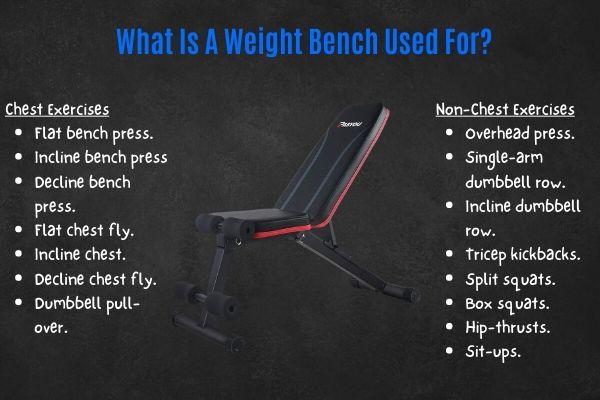
Aside from being a comfy platform to sit on, the weight bench serves an important function.
The bench allows you to perform a variety of barbell and dumbbell chest exercises using said free weights:
- Flat bench press.
- Incline bench press
- Decline bench press.
- Flat chest fly.
- Incline chest.
- Decline chest fly.
- Dumbbell pull-over.
These exercises form the core of any decent chest program.
And whilst the bench is not essential to perform these lifts, it WILL make them much safer and more effective (especially at heavy loads).
The bench can also facilitate non-chest exercises:
- Overhead press.
- Single-arm dumbbell row.
- Incline dumbbell row.
- Tricep kickbacks.
- Split squats.
- Box squats.
- Hip-thrusts.
- Sit-ups.
Again, all these exercises can be executed without a bench.
But having a stable platform to rest your body on, will help you perform these lifts more effectively.
Next, I’ll explain why a bench is often used with dumbbells. And specifically, why a weight bench is recommended for chest exercises.
1) A weight bench gives dumbbells A full ROM.
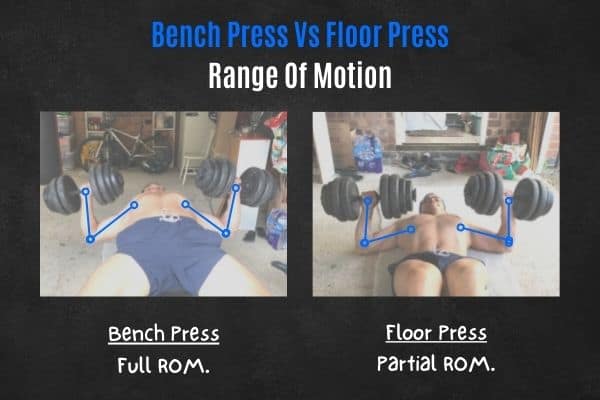
The first reason why you would use a bench for dumbbell chest exercises is for maximum ROM.
ROM stands for “range of motion“.
It describes the ability of a joint or limb to go through its full spectrum of extension (increasing joint angle) and flexion (decreasing joint angle).
In weight training, you’ll often hear the phrases “full” and “partial” range of motion.
A full-range of motion moves the joint to it’s farthest point of extension/flexion, whilst a partial-range of motion moves the joint within the limits of extension/flexion.
Mike Matthews, Legion Athletics.
In the example of a dumbbell bench press (see image above):
Laying on a bench allows the dumbbells to drop further down because the elbows can go below the torso. And this gives you a full ROM (aka “a full rep”).
In comparison, laying on the floor prevents the dumbbells from going all the way down because the elbows can’t physically go below the floor. And this gives you a partial ROM (aka “a half rep).
Later, I’ll explain why ROM is important.
Check out my other article to find out if dumbbells are worth the price!
2) A bench confers dumbbells different angles.
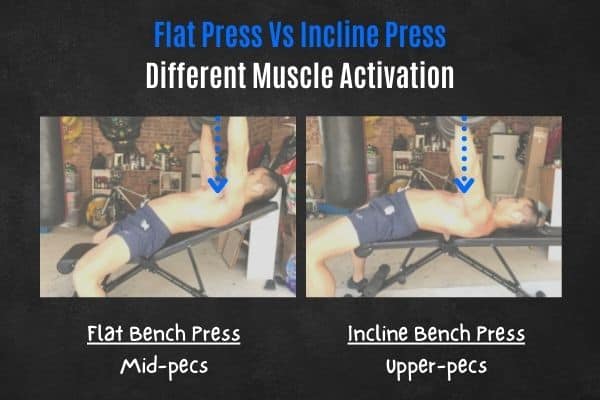
Large muscles, such as the pectorals, often span a wide spacial area.
Think about it- your pecs cover the entire width and height of your chest right?
This makes it important to change the angle of a chest exercise to target specific regions.
That’s because changing the angle also changes the specific region that the weight falls above.
Each bench press angle activates a different chest muscle.
Old School Labs.
Take a look at the example of a dumbbell bench press (see image above):
In the flat dumbbell press, the dumbbells fall directly over (and emphasize) the mid-pectorals. As a result, the flat dumbbell press is great for developing a mid-chest.
Now compare this with the incline dumbbell press, where the dumbbells fall above (and emphasize) the upper pectorals. As a result, the incline dumbbell press is awesome for upper-chest development.
Ultimately, changing the angle emphasizes different regions of the same muscle.
And a weight bench allows you to do this with minimal fuss.
Do You Need A Weight Bench For Your Dumbbells?
Now you know the benefits of using a weight bench with your dumbbells (ROM and angles).
But the question remains.
Is a weight bench really necessary?
A weight bench is not necessary for a simple chest workout. Other exercises engage the chest muscles without the requirement for a bench. However, a sturdy adjustable bench is recommended to develop maximum chest strength and size. Creative weight bench alternatives also exist.
Ultimately, for most people, a weight bench is a luxury and not a necessity.
Whilst for others, a weight bench can be one of the best investments they make.
Now, you may still be undecided as to which bucket you fall under.
So here are some situations where a bench will benefit your dumbbell training, and some situations where a bench may be completely unnecessary.
Hopefully, this will help you make a decision!
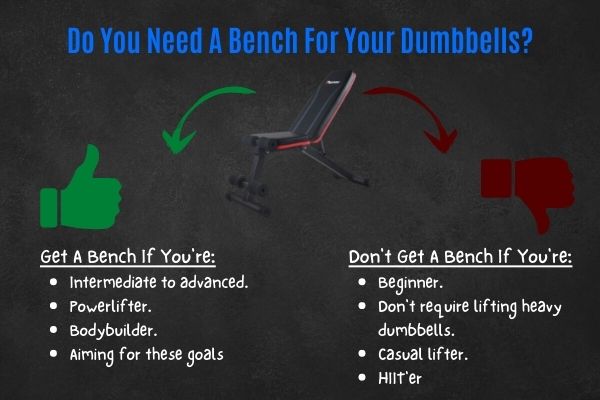
Situations when a bench is highly recommended:
These people will benefit greatly from using a bench with their dumbbells:
- Intermediate to advanced lifters. At this training level, most people who train their chest WILL and DO use a weight bench on a regular basis (for a full ROM and different chest angles).
- Powerlifters looking to maximize chest strength. The bench press is a core exercise for powerlifters and those looking to build chest strength. To do this, you need to lift heavy. A bench is the safest way to load heavy weight on a bench press.
- Bodybuilders looking to sculpt their bodies. The dumbbell press/fly are both extremely popular with pro and casual bodybuilders for a good reason. They are fantastic chest-builders. And the angles and ROM offered by a bench will help you build the best physique possible. A bench will also allow you to safely lift heavy on these exercises.
- Beginners with long-term goals related to the above. If you aspire to any of the goals above, then a bench will be invaluable. The one-time purchase will most likely last you a lifetime.
Generally speaking, get a bench if you want to maximize your chest workouts and have the money for it (which btw isn’t much as you’ll see later)!
Situations when a bench isn’t necessary.
These people will find that using just dumbbells is perfectly fine and does not require a bench:
- Beginners who have just started working out. Walk before you run. There are lots of dumbbell chest exercises that don’t require a bench (I’ll detail them later). Save your money for now, work on these other exercises, and then decide later when you’re 100% committed to training.
- If you don’t intend to lift heavy. It’s perfectly reasonable to do dumbbell chest exercises at lighter weights without a bench. You can also try making your own DIY weight bench instead (I’ll give you some examples later).
- Casual lifters who aren’t interested in maximizing chest strength and size. Not everyone is looking to build a bodybuilder’s/powerlifters’s chest. Many dumbbell chest exercises can help you make chest gains without the need for a bench. These gains may not be as pronounced as they would be with a bench, but can still be noticeable.
- Dumbbell HIIT’ers. Dumbbell workouts with HIIT/cardio/toning in mind, don’t need a bench. Floor and standing dumbbell exercises are perfectly fine.
Generally speaking, save your money if you’re a beginner or a casual lifter. Then make a decision after 6 months of training.
58% of weight lifters advise you to first consider your goals.
Still undecided about whether or not you should get a bench with your dumbbells?
Maybe peer opinion can help you decide.
I polled the following Reddit and Facebook communities:
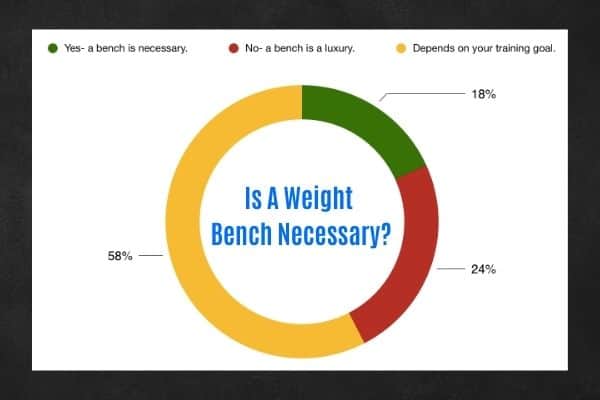
The verdict is clear.
The majority 58% of people agree you should consider your training goals before deciding whether you need a weight bench or not.
Basically- if you’re looking to dumbbell bench press the heaviest load possible, then get a bench.
Otherwise, save your money!
In fact, only 18% of people said that a bench is essential for a home gym setup, whilst the remaining 24% of people consider it an unnecessary luxury.
My advice?
Get a bench if you’re 100% sure you want to build a strong and balanced upper body.
Otherwise, get your dumbbells first, train for a few months, then make your decision further down the line.
You may plan to be a casual lifter, but weight training can be addictive.
Before you know it, you’ll want to beat your personal bests.
At this point, you may want to consider buying a weight bench.
If you’re looking to buy a bench, you may be interested in my other article which reveals how much you should pay for a weight bench.
Why A Weight Bench Is Great With Dumbbells.
Now, I’ll go into further details as to why a bench can maximize the results from dumbbell workouts.
1) Benches provide a stable surface for flat and incline exercises.
USMLE Step 1 is going to be pass/fail.
Bench press:body weight ratio for Med students applying for ortho just became a hell of a lot more important! pic.twitter.com/hZT2G4EQQ9— Naan Derthaal, DO, FAAOS (@NaanDerthaal) February 13, 2020
A weight bench provides a strong and sturdy surface for you to lay on.
As a result, you’ll also have a safe and stable base from which to press/fly your dumbbells.
Without a stable surface, you’ll find a lot of energy is wasted on simply stabilizing your position.
And this detracts from why you’re doing presses/flyes in the first place- to hit your mofo chest with as much weight as humanly possible!
Now, this is honestly not that big a deal when benching/flying in flat positions because you can just lay on the floor or use other household items as a bench alternative.
However, it does become an issue for incline positions (like the incline dumbbell press) because you’ll struggle to find a household object with the same incline ergonomics as a weight bench.
Therefore a bench can help a lot when performing the incline dumbbell press/fly.
2) Bench stability allows you to lift heavier dumbbells.
Generally speaking, the more stable your position, the more weight you can lift.
That’s why experienced lifters often plant their feet on the ground and arch their back during the bench press.
This position is much more stable than having your legs flailing about and the back wiggling all over the place.
Furthermore, lifting heavy weights is essential for strength development.
Therefore a weight bench is essential (for safety’s sake) if you want to lift heavy dumbbells to maximize chest strength.
Here’s an example of the weight differences between a dumbbell bench press vs floor press:
| Bodyweight (lbs) | Dumbbell Bench Press (lbs) | Dumbbell Floor Press (lbs) | % Difference |
|---|---|---|---|
| 120 | 38 | 34 | 11 |
| 140 | 52 | 48 | 8 |
| 160 | 66 | 62 | 6 |
| 180 | 78 | 74 | 5 |
| 200 | 90 | 86 | 4 |
| 220 | 102 | 98 | 4 |
| 240 | 114 | 110 | 4 |
| 260 | 124 | 122 | 2 |
You can see that pressing with dumbbells on a bench allows you to lift around 6% more weight, compared to pressing with dumbbells on the floor.
Take home message?
A bench can help you get a stronger chest much faster!
Check out my other article to help you decide if you should get a weight bench for your home gym!
3) Benches provide a comfortable lifting surface.
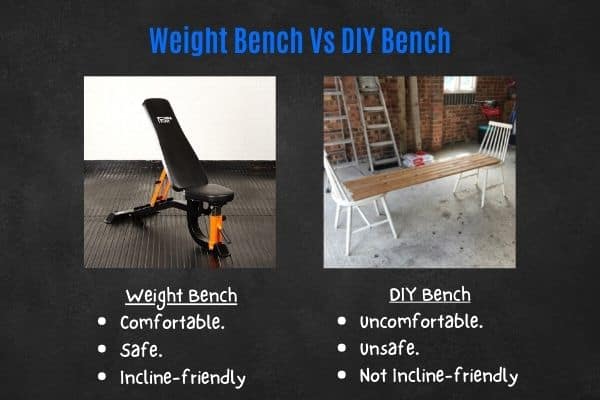
Many people make their own DIY weight bench. And it really isn’t all that difficult (I’ll give you examples later).
Can a DIY bench provide a stable surface? Probably (if you use sturdy materials).
Will it be as comfortable or as safe as a purpose-built weight bench? Probably not!
All modern benches feature foam padding.
They also have a purposely designed narrow profile that allows your elbows to move freely above/below the torso midline.
Combined, this provides a very comfortable and functional platform to lift your dumbbells.
Therefore if your DIY weight bench isn’t cutting it, it may be time to spend the money on a weight bench!
4) Greater ROM leads to greater muscle activation.
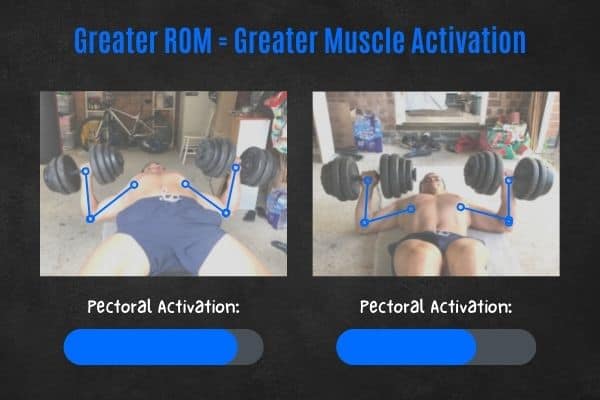
Previously, I mentioned that a bench allows your dumbbells a greater ROM (range of motion).
That’s because the bench can support your back without getting in the way of your elbows.
And this allows your elbows to move freely below the torso midline.
But why is a full ROM better than a partial ROM?
This 2020 meta-study found that a full ROM is more beneficial for hypertrophy (muscle growth), compared to a partial ROM.
The authors further suggested that this is due to greater muscle tension and activation generated in a full ROM.
So if your chest strength isn’t improving, you may want to try using a bench with your dumbbells!
Check out my other article for the most common reasons your chest isn’t growing!
5) Angles are essential for balanced chest growth.
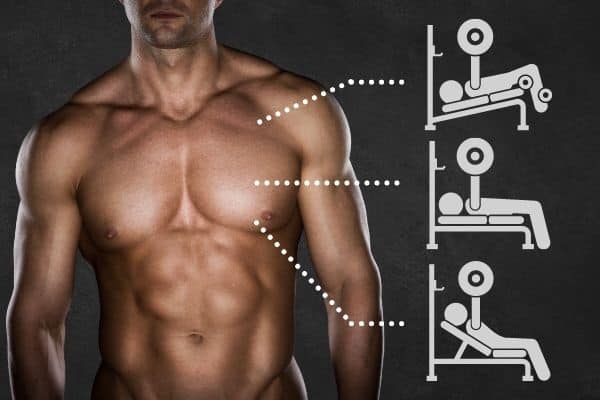
The pecs comprise 3 main regions: the upper, mid, and lower pecs.
Each region is best targeted by pressing/flying movements performed at different angles.
This has been shown in a 2020 study that used EMG to compare muscle activity in the upper/mid/lower pecs and front deltoids when bench pressing at 0°/30°/60°.
This is what the authors found:
- 0° bench pressing led to the greatest mid and lower-pec activity.
- 30° bench pressing led to the greatest upper-pec activity.
- 60° bench pressing led to the greatest front deltoid activity.
This is why a bench is highly recommended for sculpting the best physique possible with dumbbells.
So if you find your chest definition to be lackluster, it may be wise to invest in a bench!
Go to my other article to learn how to get a bigger chest with dumbbells!
8 Chest Exercises You Can Do Without A Bench.
If you’ve decided a bench isn’t necessary for your needs, great!
Here are 8 of my favorite exercises to use dumbbells without a bench.
Combined, these dumbbell exercises will work all of your pectoral regions.
1) Dumbbell floor press.
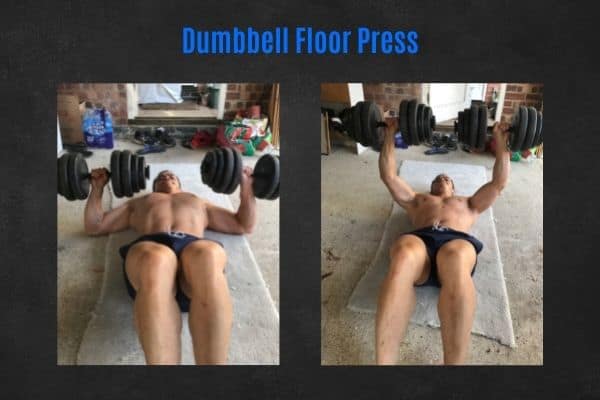
How to do it:
- Lay flat on the floor.
- Hold a pair of dumbbells in each hand using an overhand grip at shoulder-width apart (dumbbells should be be at the nipple-line).
- Press the dumbbells upwards and bring them together at the top.
- Lower the dumbbells back to the starting position.
Replaces bench exercise:
Dumbbell flat bench press.
Muscles worked:
Mainly the mid-pecs but also the upper-pecs, lower-pecs, triceps, front deltoids (to a smaller degree).
Top tip:
Keep your feet and buttocks planted onto the ground, but arch your mid-back. This will ensure you are pushing the dumbbells with your chest rather than your arms.
Laying on a Yoga mat helps to stop you from sliding about as you lift. A yoga mat also stops your carpet from being drenched in your own sweat!
2) Decline dumbbell floor press.
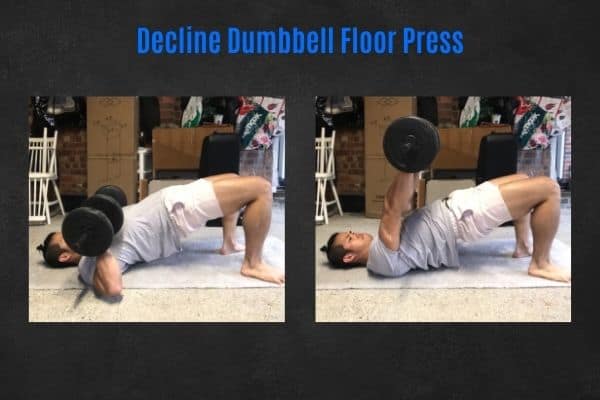
How to do it:
- Enter a glute bridge position (back on the floor with hips raised and feet planted on the ground).
- Hold a pair of dumbbells using an overhand grip shoulder width apart.
- Press the dumbbells upwards as you would on floor press.
- Lower the dumbbells back whilst maintaining the glute bridge position.
Replaces bench exercise:
Dumbbell decline bench press.
Muscles worked:
Mainly the lower-pecs but also the mid-pecs, upper-pecs, triceps, and front deltoids (to a lesser degree).
Top tip:
At the top of the movement, the dumbbells should be above the nipple line rather than above the mouth. This will ensure maximal lower chest contraction.
Lay on a yoga mat for the reasons described previously. Cheap ones like this Balance Form Mat can be delivered fast and cheaply from Amazon.
3) Stability ball dumbbell press.
How to do it:
- Lay your upper back and head on a bosu/yoga ball with your feet planted on the ground.
- Keep your hips thrusted upwards to maintain a straight back.
- Press the dumbbells as you would with a floor press.
- Lower the dumbbells whilst maintaining a straight and stable back.
Replaces bench exercise:
Dumbbell flat bench press.
Muscles worked:
Mainly the mid-pecs and core but also the lower-pecs, upper-pecs, triceps, and front deltoids.
Top tip:
Slow the lifting temp. This can be a hard exercise to do as it requires a lot of stability. By lifting slow, you’ll maximize chest engagement and limit the “bouncing” of dumbbells up and down as a result of the ball’s inherent elasticity (fun but useless).
Yoga balls can be found cheaply on Amazon if you don’t already have one. I have the Pro Body Pilates ball. It’s made from a non-rubber PVC that’s odor-free unlike some I’ve used in the past. The material is also firm enough to hold bodyweights up to 250lbs, yet supple enough to be comfortable.
4) Dumbbell floor fly.

How to do it:
- Lay flat on the ground.
- Hold dumbbells in together each hand above the head, using a neutral grip.
- Lower the dumbbells to either side, keeping a slight bend in the elbow.
- Bring the dumbbells back together once the upper arms touch the floor.
Replaces bench exercise:
Dumbbell flat chest fly.
Muscles worked:
Mainly the mid-pectorals and biceps but also the upper-pecs and lower-pecs (to a lesser degree).
Top tip:
Maintain 120° in each elbow. The elbows should not be locked (i.e. not straight arms). Locking your elbows will strain your joints and can be painful.
5) Stability ball dumbbell fly.
How to do it:
- Lay your upper back and head on a bosu/yoga ball with your feet planted on the ground.
- Hold dumbbells together each hand above the head, using a neutral grip.
- Lower the dumbbells to either side whilst maintaining your balance, keeping a slight bend in the elbow.
- Bring the dumbbells back together once the upper arms are parallel to the torso horizontal plane.
Replaces bench exercise:
Dumbbell flat chest fly.
Muscles worked:
Mainly the mid-pectorals, biceps, and core but also the upper-pecs and lower-pecs (to a lesser degree).
Top tip:
Actively squeeze the dumbbells at the top. Doing this will be much harder than not squeezing the dumbbells together, but it will also maximize chest contraction and work your core harder.
6) Standing dumbbell chest fly.
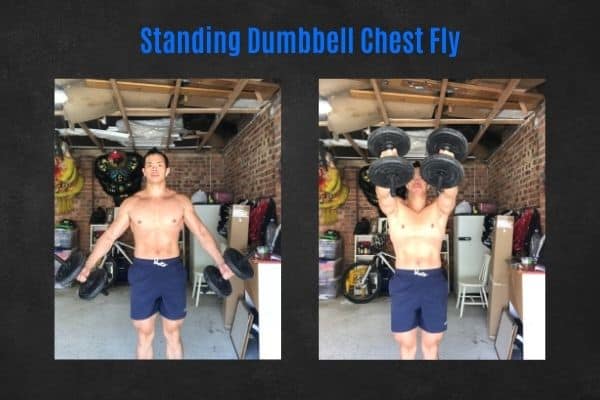
How to do it:
- Stand with feet shoulder-width apart, holding dumbbells in both hands using a neutral grip.
- Bring the dumbbells upwards and together whilst keeping a slight bend at the elbows.
- Stop when the dumbbells reach the nipple-line.
- Lower the dumbbells to your sides.
Replaces bench exercise:
Dumbbell flat and incline chest fly.
Muscles worked:
Mainly the mid-pecs, upper-pecs, and front deltoids.
Top tip:
This is a hard exercise for beginners and experienced lifters alike. That’s because it’s a movement that you don’t usually perform during daily activities, and therefore requires a lot of stabilization from unused muscles. So start with a light load first and then slowly increase by a couple of pounds each week.
Check out my other article to find out if you should get home dumbbells or gym membership!
7) Standing dumbbell crossover.
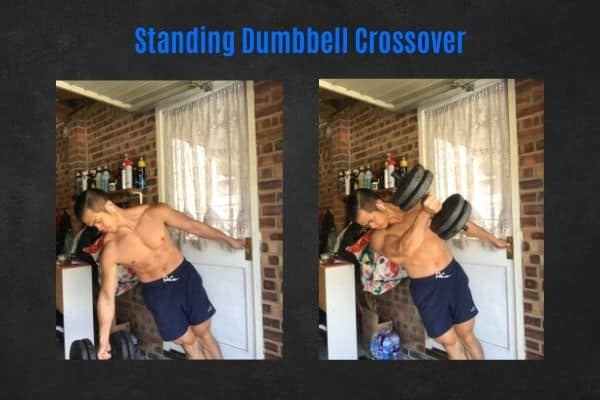
How to do it:
- Stand with feet shoulder-width apart, holding a single dumbbell in one hand using a neutral grip.
- Bring the dumbbell upwards and across the chest whilst maintaining a slight bend in the elbow.
- Stop when the dumbbell reaches the opposite shoulder.
- Lower the dumbbell to your side.
Replaces bench exercise:
Incline dumbbell chest fly.
Muscles worked:
Mainly the upper-pecs and front deltoids but also the mid-pecs and biceps (to a lesser degree).
Top tip:
Hold onto a door handle, plant both feet together onto the ground, and lower your body to the opposite side into a slanted position. This will further emphasize upper-pec activation.
8) Stability ball pull-over.
How to do it:
- Lay your upper back and head on a bosu/yoga ball with your feet planted on the ground.
- Form a diamond shape with the thumb/finger of both hands and clasp a single dumbbell over your head by resting the flat portion of the dumbbell on the flats of your palms.
- Arc the dumbbell down and behind your head.
- Stop when your arms are in line with your torso.
- Arc your arms upwards to bring the dumbbell back above your head.
Replaces bench exercise:
Dumbbell pull-over.
Muscles worked:
Upper-pecs, triceps, and core.
Top tip:
Maximize upper-chest activation by allowing the dumbbell to rest on the palms (supported by your palms). But avoid actively squeezing the dumbbell because this makes it tempting to use your arm strength to help lift the dumbbell instead of using your upper chest strength.
Go to my other article to learn how much dumbbells should cost!
A Good Weight Bench Doesn’t Have To Cost Much
A weight bench may look and sound like an expensive piece of kit.
But have you actually checked the prices?
I don’t mean to be patronizing, but from my experience, it’s easy to completely disregard a bench without actually doing a price check first.
So if you’re still on the fence regarding purchasing a bench for your dumbbells, you may want to hear me out.
Don’t miss out on a cheap bench!
Compared to the other popular home gym items, a weight bench is one of the cheapest bits of kit.
And in my opinion, they are also one of the best value for money.
In fact, my weight bench is my favorite home gym investment to date.
So how much does a workout bench cost?
On average, workout benches will cost around $200. Premium models can cost $300 to over $500 per bench. However, many budget models are available for as little as $70 to $150. Even a budget bench is sturdy, durable, and great for beginners lifters to begin building a home gym.
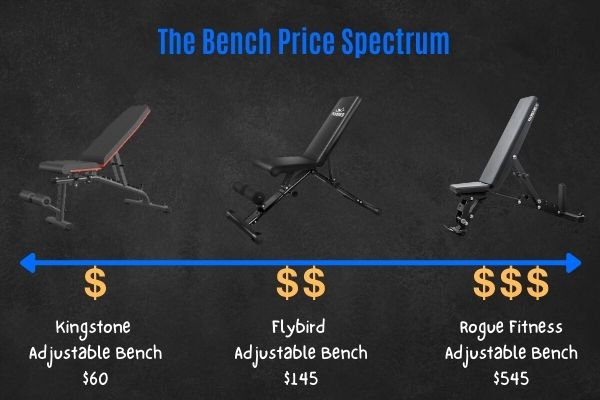
$70 for a bench is not that big a deal for most people.
So you may not want to miss out on a great purchase opportunity due to ignorance.
Here are some of my favorite weight benches for different budgets:
- Rogue Fitness adjustable bench 2.0 ($545).
- Rep Fitness AB-3100 ($249).
- Keppi adjustable weight bench ($149).
- Flybird adjustable weight bench (145).
- Ativafit adjustable weight bench ($99).
- Linodi adjustable weight bench ($89).
- Kingstone adjustable weight bench ($69).
These all score at least 4.5 out of 5 stars and have fantastic reviews.
Obviously, the premium models will look and feel more like the commercial benches you find at the local gym.
But even the cheaper ones will do the job nicely and often last you a lifetime.
I have the Flybird adjustable weight bench (see the full review here). And it’s hands down my favorite home gym purchase so far.
Avoid buying the wrong bench for your dumbbells!
If you’re gonna buy a weight bench for your dumbbells, you should be careful not to buy the wrong one.
So what is the best weight bench to get?
In general, adjustable weight benches are the best type of bench. They are versatile and allow for different angles, including flat, incline, and decline settings. Many are also foldable and allow for quick and convenient storage when not being used.
Other bench types include Olympic and flat benches.
These have very specialized purposes (mainly powerlifting-type movements).
They aren’t recommended for beginners or casual lifters!
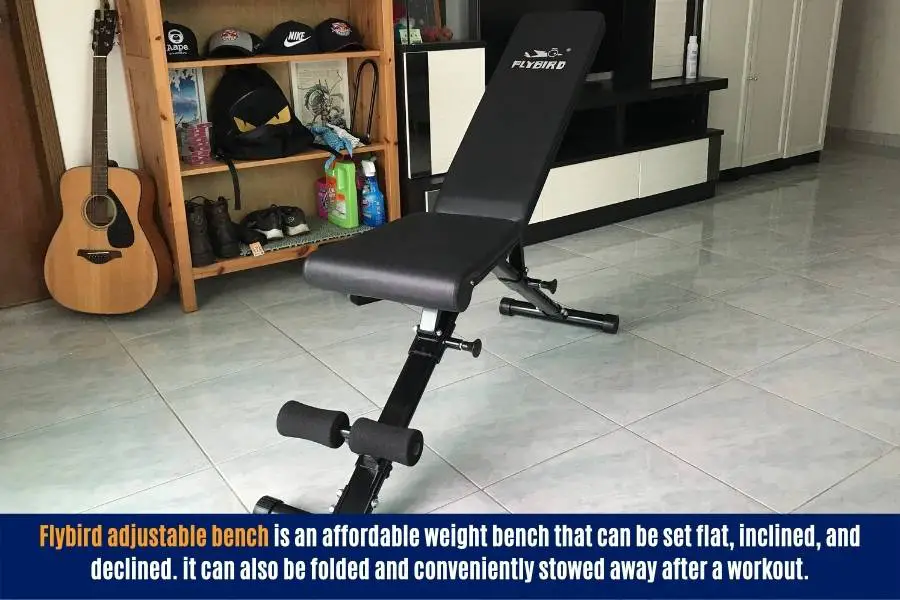
As a beginner or intermediate, I highly recommend a cost-effective mid-range adjustable bench. Having tested dozens of benches, two of my favorites are:
- Flybird adjustable weight bench– this is great for people between 5″6″ to 6’0″.
- Fitness Reality Supermax 2000– this is a more comfortable option for people taller or shorter than 5″6″ to 6’0″. It has a longer backrest to better accomodate tall people and a lower seat height which is better for short people.
Both benches have a 700lb+ weight capacity, are comfortable, and offer good stability. Both of them can also be folded and stowed away after a workout.
You might be interested in my other article which shares 7 of my favorite dumbbell benches!
6 Awesome Weight Bench Alternatives You Can Make At Home.
A weight bench is the safest and most practical way to do dumbbell chest exercises.
But if you don’t want to spend money buying one, you can go down the DIY route instead.
Here are 6 great alternatives you can use instead of a weight bench:
1) A piano bench is comfortable and sturdy.

This is one of my favorite weight bench alternatives.
A piano bench can be found in many households, and they are both sturdy and comfortable.
They often have a firm but padded seat, and this makes them ideal to use with your dumbbells.
The only issue is they can be quite short length-wise.
To solve this problem, you can lay your back and upper back on the bench, with your legs overhanging at the end.
Then plant your feet firmly on the ground and engage your glutes/core to maintain a straight back.
2) Make a homemade bench with 2 chairs and a plank of wood.
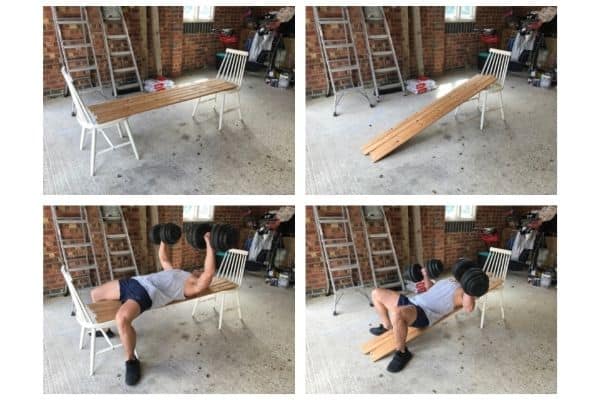
Have got 2 chairs and a plank of wood? If so, you can make your own bench.
Have the two chairs facing each other and bridge the gap using the wooden plank.
Chairs with a holed back are ideal since you can adjust the length of your bench by sliding the two chairs closer/farther away from each other.
Just make sure the wood can take your weight.
Old wooden bed slats are great for this. Also, keep the bench length as short as possible.
The shorter the bench, the more weight it can take (wow physics class finally came of use).
You can also remove one chair to make a DIY incline bench!
You may be interested in my other article for other creative incline bench alternatives to train your chest at home!
3) Use a yoga, exercise, or stability ball.
Yoga balls are also common in many households, and they make a great bench alternative.
They aren’t great for using with heavy dumbbells though.
That’s because they are very unstable and require a lot of balance.
To help maximize balance, you can try planting your feet firmly on the ground with a wide stance. You can also push your hips upwards as much as possible, whilst your back is laying on the ball.
This helps to stabilize your body as you use your dumbbells.
4) Laying on the floor is great.
Most of the flat bench chest exercises don’t require a bench.
You can just lie on the floor instead.
It’s safe and it works surprisingly well.
In fact, I was able to maintain my chest size by doing floor presses at home during the 2020 gym lockdowns.
So I’m sure it will work for you too!
Obviously, the floor won’t provide as much ROM as a bench (as explained previously), but it’s still a great backup option.
Laying on the floor can also be extremely beneficial because it prevents you from cheat lifts.
People are often tempted to swing their hips upwards and use this momentum to help them bench a dumbbell that’s too heavy for them.
This is not recommended as it reduces target muscle activation (the chest). And bench pressing on the floor can help reduce this cheating.
Floor presses are also better than using a yoga ball in my opinion.
That’s because the floor is much more stable than the yoga ball.
And this means you’ll be able to lift more weight!
Check out my other article for more weight bench ideas you can make at home!
5) Bodyweight exercises don’t require a bench.
Don’t forget that many bodyweight exercises are perfectly fine for beginners to work on their chest.
In fact, you shouldn’t just limit yourself to dumbbell training.
Instead, mix things up occasionally to keep your muscles challenged.
Here are my favorite bodyweight chest exercises:
- Standard pushup- replicates the flat dumbbell bench press.
- Dumbbell pushup- a harder and more effective variation of the standard push-up (complete guide here).
- Incline pushup- replicates the decline dumbbell bench press.
- Decline pushup- replicates the incline dumbbell bench press.
- Typewriter pushups- replicates the dumbbell chest fly.
- Dumbbell-weighted dips- amazing exercise for general chest development (lean forward to really engage the chest).
- Wide arm pushups- emphasize the chest more than the arms.
- Narrow arm pushups- emphasize the arms and inner chest.
6) Resistance bands are a cheap alternative to a bench.
Ok, this isn’t really a weight bench alternative, but still, something to consider.
You can pick up a set of bands for 100 bucks and they are great for working the chest.
Most sets will also come with anchors which secure onto doors. And this allows you to do standing press/fly movements.
Don’t underestimate the bands either.
When you combine multiple bands together, they will provide enough resistance for most people!
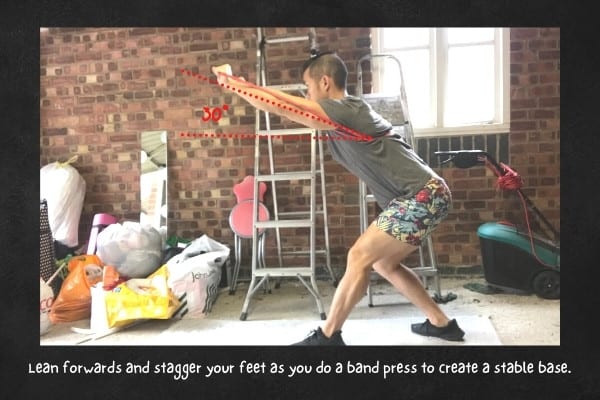
I use and recommend the Undersun Bands. They’re a cheap and convenient way to train the entire body. They also come with a lifetime warranty!
Don’t forget to get gloves too. These protect your hands from friction burns. I found cheap ones like the Ihuan ventilated neoprene gym gloves do the job perfectly well.
Recommended Gear List
Here’s a recap of the recommended gear in this article:
| Recommended Gear | Reason |
|---|---|
| Flybird Adjustable Bench | Affordable bench for people between 5’6″ to 6’0″ |
| Fitness Reality Supermax 2000 Bench | Affordable bench for people outside 5’6″ to 6’0″ |
| Powerblock Elites | Great dumbbells for the above two benches. |
| Balance Form Yoga Mat | Non-slip surface for no-bench dumbbell floor exercises |
| Pro Body Pilates Ball | Cheap alternative to a weight bench. |
| Undersun Resistance Bands | An affordable way to train the entire body (including) the chest, without a bench. |
| Ihuan Gloves | Protects hands from resistance band friction burns. |
Conclusion
I’ve explained whether or not you need a bench for your dumbbells.
Whilst a weight bench is extremely beneficial for maximizing your chest workouts, they aren’t essential.
I made do without a bench for 1 year and I was still able to make chest gains.
But towards the end of that year, I found that floor/standing dumbbell exercises just weren’t cutting it for me anymore.
And that’s when I decided to take the plunge.
It was the best investment ever!
My advice?
If you have the spare cash and are 100% committed to training, buying a weight bench will be a great investment.
But if you’re just starting out, or a casual lifter, try the floor/standing exercises described in this article first.
You can also try making your own bench using the ideas I gave you!
Will you be buying a bench?
Let me know in the comments!
You may also be interested in the downloadable Kalibre Blueprint PDF which details exactly how I gained 40lbs of lean muscle (it’s 100% free!). It gives the exact exercises and nutrition I used to go from skinny to ripped!
Thanks for reading guys!
Peace Out,
Kal
(Biochemistry BSc, Biomedical Sciences MSc, Ex-Skinny Guy).


